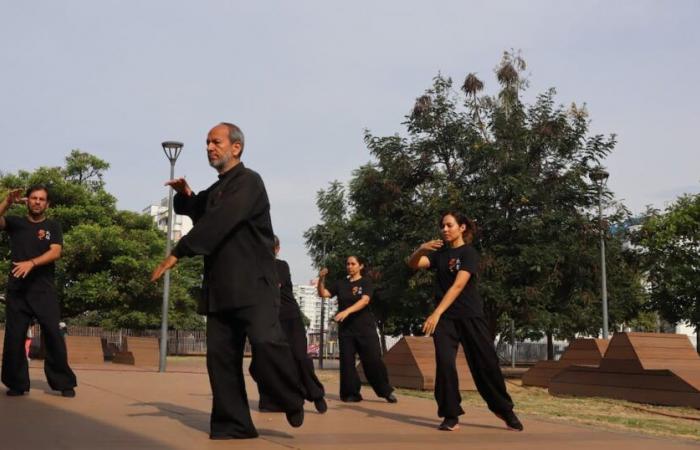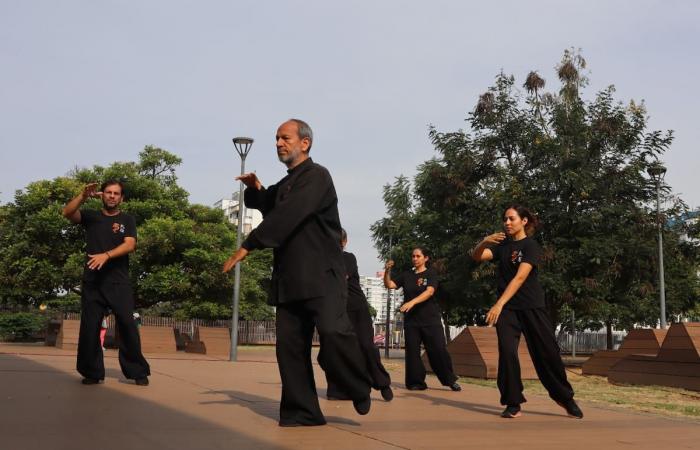In a hurry and noise times, Bucaramanga will pause. This Saturday, April 26, the city will join a world wave of calm and internal connection with the celebration of the International day of Tai Chi and the Qigong.
This Saturday, April 26, Bucaramanga will join the global celebration of the International Day of Tai Chi and the Qigong, a date that promotes physical and mental health through these millenary Chinese practices. The Industrial University of Santander (UIS), at its headquarters in La Perla, will be the epicenter of this commemoration, with activities scheduled from 9:00 am to read: Tie-Dye in Bucaramanga: textile art and creativity during the Pal’alma Festival
Since 1999, on the last Saturday of April World Chi and Qigong Day in more than 80 countries has been celebrated, with the aim of spreading the therapeutic and spiritual benefits of these disciplines. In Bucaramanga, the Ecotay community, led by Master Mauricio Barajas, has been fundamental in promoting these practices, offering spaces for meeting and healing in parks and public spaces of the city.
The Sifu Mauricio Barajas, has a serene presence and a deep look of those who have patiently walked the paths of internal art. For him, Tai Chi is more than a physical discipline: “It is an encounter between heaven, human and earth,” he says. “That is why we work 80 % mind and 20 % body. The physical is just the entrance door to something much bigger: a life mission.” And in an era where the urgent runs over the essential, that proposal acquires an urgent value.
One of its members, Andrés Paillié arrived at Tai Chi during the pandemic, at a time of global chaos and personal crisis. He discovered, from his home, that the body could move meaning even in minimal spaces. That slowness was not a defect, but a medicine. “I am hyperactive, I always want to do a thousand things at the same time, and that exhausts me. Tai Chi helped me do things in order. To be,” he confesses.
His story is not just personal, it is also generational. It represents many who have been trapped by the digital vertigo, by eternal multitasking, by tiredness without a name. For him, Tai Chi was more than a physical practice: “It is a spiritual connection. A path to reconnect with something superior, something that I did not understand before. And no, it is not a religion. It is simply to believe again.”
Laura Vila, a monitor of Second Duan and promoter of Tai Chi in the region, highlights how this practice has transformed her life, providing her self -esteem, healing and the possibility of releasing painful memories. “For me, Tai Chi is a rebirth,” he says with emotion.
The day in the UIS will include demonstrations, open classes and moments of meditation, inviting citizens to experience the benefits of Tai Chi and Qigong. These practices, which combine soft movements, conscious breathing and mental approach, are accessible to people of all ages and physical conditions.
The celebration in Bucaramanga is part of a global wave of events that seek to promote peace, health and spiritual connection through Tai Chi and the Qigong, reminding us of the importance of stopping, breathing and reconnecting with our interior.

What is Tai Chi?
The Tai Chi Chuan, whose full name is translated as “Supreme Fist last”, is a practice of martial origin that evolved towards a form of moving meditation. It emerged in China during the seventeenth century, although its roots date back to old Taoist and Buddhist techniques that sought the harmony between body and mind. Throughout the centuries, various schools developed styles such as Chen, Yang, Wu and Sun, each with their particular way of executing the movements, but all with the same essence: the balance of the “Chi” or vital energy.
Beyond its origins as martial art, today Tai Chi is practiced throughout the world as a body therapy that improves flexibility, strengthens the immune system, reduces stress and help in the treatment of chronic diseases such as arthritis, hypertension and anxiety.
How is Tai Chi practiced?
Tai Chi is practiced by means of slow, fluid and continuous movements, which are performed in synchrony with deep and conscious breathing. Although he was born as a martial art, today he is practiced more for his therapeutic and meditative benefits than for his personal defense.
1. Soft and coordinated movements
- Each session includes a series of chained postures that are slowly executed.
- Movements simulate defense or attack actions, but there is no physical contact or abrupt effort.
- The essential thing is to keep the body relaxed but aligned, and move as if the body floats in the water.
2. Conscious breathing
- The rhythm of the movements goes hand in hand with abdominal, slow and deep breathing.
- Inhaling and exhaling becomes a guide that helps connect the body with the mind.
3. Full concentration (mindfulness)
- Tai Chi is also a form of moving meditation.
- It is practiced with attention to the present, feeling every movement and breathing, which helps reduce stress and improve the approach.
4. Energy work (Chi or Qi)
- According to Chinese philosophy, Tai Chi helps the “chi” (vital energy) flow freely through the body.
- It works to unlock energy channels (meridians) to balance the body and strengthen health.
Where and how often is it practiced?
- Quiet and open spaces are ideal: parks, large rooms or patios.
- No special equipment or costume is needed, only comfortable clothes.
- It is recommended to practice it daily or several times a week to notice its benefits, although even once a week it can be very valuable.
Who can practice it?
Anyone! From children to older adults. It is especially useful for:
- People with chronic diseases (such as arthritis or hypertension)
- Older people (due to their low impact and benefits in balance)
- People with anxiety, stress or insomnia
- Athletes in recovery or as a complement to other training







